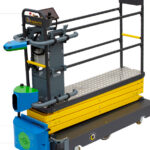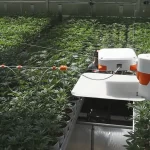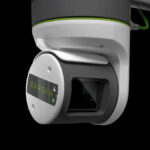First Arrivals:

Although the automation of insect scouting and crop forecasting have seen tremendous strides in the past five years, new players to the field are poised to restructure the industry. Early-in players such as Ecoation and IUNU attracted significant attention and customers. Their cart mounted cameras established that automated recognition and mapping of insect infestation and crop growth are practical and worth the investment. Newer arrivals, such as View-Netic, are bringing smaller, lighter cameras to the market. Some of these are hand-held, allowing a grower to walk directly to a greenhouse area of concern, map it and assess it.
Features common to older mobile camera technologies:
- The scans of the greenhouse are periodic. Scan results are only as fast or fresh as the cameras are sent out.
- There is a significant labour input in every scan. Someone needs to ride the cart with the camera, monitor a semi-autonomous cart or carry the camera itself. This may involve less labour than a completely manual scan. But, it’s a long way from no labour at all.
Mobile Camera, No Labour:
New players such Neat Leaf bring a fresh

approach. Neat Leaf uses a camera called Spyder to ride a web of cables back and forth over the crop to generate images. The camera moves quickly and is available 24/7. The camera can be directed from the grower’s office.
New Players: Stationary Cameras
More recent arrivals in the field of scout technology use cameras fixed in place. Scans are done 24/7. If a grower has an interest in only one part of the greenhouse, the camera is already in position to give instant results. No labour is required to zero in on a target growth zone. Suppliers of stationary camera technology, such as Fermata, have been in play for a few years.
But new players such as Gardin bring a fresh

approach. Gardin, a British company, uses stationary cameras to evaluate crop health by directly measuring the plant biology using chlorophyll fluorescence. Gardin’s analytics alert growers to any issues such as drought, disease and heat stress within hours. Their cameras were developed by their CEO, Sumanta Talukdar, who had already a successful career in optics before starting Gardin.

Iridesense.Tech also peers into plants using proprietary, robust, low cost solid state lasers. At each frame, the laser beam scans at different positions of space to generate instantaneous imagery.
Faster, Cheaper:
The new technology arrivals are certain to deliver a more fundamental analysis of plant health and insect activity faster and for less money than the companies which first brought this technology to the market. Stay tuned.
